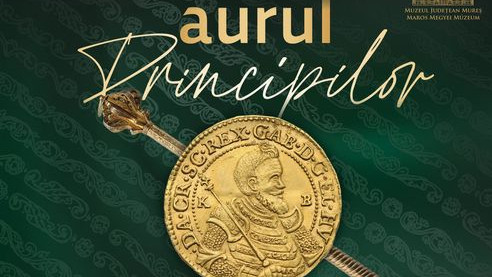The Gold of Princes - exhibition

Jul-22
The gold of princes. Ruler representation in Transylvania
temporary exhibition at the Mures County Museum
The Mures County Museum, in cooperation with the Hungarian National Museum, the Hungarian Mint Museum and Visitors Centre, the Szekler Museum of Cesky and the Szekler National Museum, opens the exhibition The Gold of Princes. The exhibition "Representation of the Sovereigns in Transylvania". The large-scale exhibition, which is the result of extensive cooperation, will be on display at the Palace of Culture in Târgu Mures from 22 July 2024, where the treasures representing the power of Transylvanian princes will be on display for the first time.
Venue: Palace of Culture, 2nd floor, temporary exhibition space.
The exhibition is open from 22 Jul 2024 - 24 Nov 2024.
Opening: Monday, 22 Jul 2024, 6 pm
Curator: dr. Csaba Tóth (Hungarian National Museum)
The exhibition presents the history of the Principality of Transylvania primarily from the point of view of royal representation. The starting point is the depictions of princes on Transylvanian coins from the 16th and 17th centuries. In the Palace of Culture, visitors will be able to see hundreds of coins, as well as decorative weapons, jewellery and objects of exceptional value. The quantity and diversity of the objects, in addition to depicting the Cordon d'Or, also give an idea of the economic and political power of the early modern Transylvanian principality.
In 2015, the Hungarian National Bank purchased from István Törő, the owner of the gallery, his unique collection of 220 Transylvanian 16th-17th century thalers, containing numerous numismatic rarities. The princely thalers were on display for the first time at the Hungarian National Museum, in the exhibition entitled Silver of the Fairy Garden, which opened in 2016. In 2017, the travelling exhibition "Princely treasures - Transylvanian thalers" was launched, in which the Törő collection was complemented by contemporary artifacts from the collection of the National Bank of Hungary and valuable pieces from the Transylvanian arms collection of the Hungarian National Museum. The Gold of the Princes. The exhibition "Representation of the Rulers in Transylvania" was created and will be presented in Târgu Mures, after Murescureda, as a result of cross-border institutional cooperation, using and enriching the material of the above-mentioned exhibitions.
They knew that...
In the self-representation of princes, both in ceremonies and in various works of art, the mace was the most commonly used instrument of power, and the sabre was the most commonly used instrument of military power.
-The depiction of the family coat of arms as a symbol of power on seals or on the reverse of coins was a common practice of all Transylvanian princes.
-The princedom was largely dominated by the issue of high-value gold florins, also known as ducats, thalers and multiples thereof, and several princes issued small coins of unknown value. This was due to two factors: the wealth of the area in precious metals, which was a prerequisite, and the taxes paid to the Ottoman Empire, initially of 10,000 and later 15,000 gold florins a year, which it was only willing to accept in 'good' money, gold florins or thalers.
-Documents are one of the most outstanding source groups in the history of the Principality of Transylvania. Privileges, i.e. letters of privilege, not only provide data on the history of families, politics, places and culture, but also illustrate the structure and language of one of the written materials of the period. The diplomas were written on rectangular parchment, in Latin, and authenticated by the signature of the issuer and a pendant seal at the end of the text. Two parts of these documents are also very important for the theme of the exhibition: the title of the diploma, in which the titles of the monarch are written, and the coat of arms on the pendants. Both elements can be seen as signs of the representation of the lords.
The exhibition offers much more than an inventory and presentation of the princely coinage legacy. In addition to the above-mentioned categories of objects, the jewellery, costumes and accessories not only shed light on the fashion of the period and the prince's need for representation, but also provide an insight into the court culture of the early modern Transylvanian princes.
The exhibition will open on 22 July 2024 at 6 p.m. The exhibition will be open until 24 November 2024 in the temporary exhibition space in the Palace of Culture (right wing, 2nd floor), from Tuesday to Friday from 9 a.m. to 4 p.m., Saturday to Sunday from 9 a.m. to 2.30 p.m. Closed on Mondays. The price of the ticket is RON 25, the discounted senior ticket RON 12, the discounted student ticket RON 6.
temporary exhibition at the Mures County Museum
The Mures County Museum, in cooperation with the Hungarian National Museum, the Hungarian Mint Museum and Visitors Centre, the Szekler Museum of Cesky and the Szekler National Museum, opens the exhibition The Gold of Princes. The exhibition "Representation of the Sovereigns in Transylvania". The large-scale exhibition, which is the result of extensive cooperation, will be on display at the Palace of Culture in Târgu Mures from 22 July 2024, where the treasures representing the power of Transylvanian princes will be on display for the first time.
Venue: Palace of Culture, 2nd floor, temporary exhibition space.
The exhibition is open from 22 Jul 2024 - 24 Nov 2024.
Opening: Monday, 22 Jul 2024, 6 pm
Curator: dr. Csaba Tóth (Hungarian National Museum)
The exhibition presents the history of the Principality of Transylvania primarily from the point of view of royal representation. The starting point is the depictions of princes on Transylvanian coins from the 16th and 17th centuries. In the Palace of Culture, visitors will be able to see hundreds of coins, as well as decorative weapons, jewellery and objects of exceptional value. The quantity and diversity of the objects, in addition to depicting the Cordon d'Or, also give an idea of the economic and political power of the early modern Transylvanian principality.
In 2015, the Hungarian National Bank purchased from István Törő, the owner of the gallery, his unique collection of 220 Transylvanian 16th-17th century thalers, containing numerous numismatic rarities. The princely thalers were on display for the first time at the Hungarian National Museum, in the exhibition entitled Silver of the Fairy Garden, which opened in 2016. In 2017, the travelling exhibition "Princely treasures - Transylvanian thalers" was launched, in which the Törő collection was complemented by contemporary artifacts from the collection of the National Bank of Hungary and valuable pieces from the Transylvanian arms collection of the Hungarian National Museum. The Gold of the Princes. The exhibition "Representation of the Rulers in Transylvania" was created and will be presented in Târgu Mures, after Murescureda, as a result of cross-border institutional cooperation, using and enriching the material of the above-mentioned exhibitions.
They knew that...
In the self-representation of princes, both in ceremonies and in various works of art, the mace was the most commonly used instrument of power, and the sabre was the most commonly used instrument of military power.
-The depiction of the family coat of arms as a symbol of power on seals or on the reverse of coins was a common practice of all Transylvanian princes.
-The princedom was largely dominated by the issue of high-value gold florins, also known as ducats, thalers and multiples thereof, and several princes issued small coins of unknown value. This was due to two factors: the wealth of the area in precious metals, which was a prerequisite, and the taxes paid to the Ottoman Empire, initially of 10,000 and later 15,000 gold florins a year, which it was only willing to accept in 'good' money, gold florins or thalers.
-Documents are one of the most outstanding source groups in the history of the Principality of Transylvania. Privileges, i.e. letters of privilege, not only provide data on the history of families, politics, places and culture, but also illustrate the structure and language of one of the written materials of the period. The diplomas were written on rectangular parchment, in Latin, and authenticated by the signature of the issuer and a pendant seal at the end of the text. Two parts of these documents are also very important for the theme of the exhibition: the title of the diploma, in which the titles of the monarch are written, and the coat of arms on the pendants. Both elements can be seen as signs of the representation of the lords.
The exhibition offers much more than an inventory and presentation of the princely coinage legacy. In addition to the above-mentioned categories of objects, the jewellery, costumes and accessories not only shed light on the fashion of the period and the prince's need for representation, but also provide an insight into the court culture of the early modern Transylvanian princes.
The exhibition will open on 22 July 2024 at 6 p.m. The exhibition will be open until 24 November 2024 in the temporary exhibition space in the Palace of Culture (right wing, 2nd floor), from Tuesday to Friday from 9 a.m. to 4 p.m., Saturday to Sunday from 9 a.m. to 2.30 p.m. Closed on Mondays. The price of the ticket is RON 25, the discounted senior ticket RON 12, the discounted student ticket RON 6.
